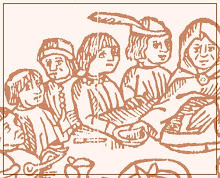I have made the interesting discovery that the Monash Uni library does not, as Melbourne's does, lock its EETS books carefully away in a distant read-only cellar where nobody ever goes, but has them on the normal shelves, where any villein can just walk in and borrow them. Having grabbed the Book of Virtues and Vices and furtively fled with it, expecting hue and cry, I shall celebrate by devoting the next week to an examination of each of the seven deadly sins, according to the 14th Century Midlands translation of the Somme des Vices et des Vertus by Lorens d'Orléans, a 13th Century Dominican friar[1].
The French original was apparently very popular. There are other English translations, and it was also translated into several other language, among them Catalan, Italian, Provencal and Flemish. It gives an intricate explanation of the nature and various sub-categories of all the vices and virtues and the main tenets of the Christian faith:
1. The Ten Commandments
2. The Articles of the Faith
3. The Seven Deadly Sins
4. Virtues
5. The Pater Noster
6. The Seven Gifts of the Holy Ghost, and the related Virtues [2]
It is precise, pedantic, heavy on the number signification and inevitably ends up duplicating some of the minor vices across different categories. It should also be remembered that it a isn't definitive guide to mediaeval thought on the subject - other similar texts from the period categorise sins differently within the basic seven. Dante's scheme was completely different, to pick the most famous example. Despite its popularity, this book is only one of the many texts analysing the relationship between intent and deed in vice and virtue that sprung up all over Europe in the wake of the Fourth Lateran Council of 1215:
Depending on his level of theological learning, the fourteenth-century man or woman could recount a large variety of sins and circumstances. He could usually identify them when they occurred in real-life situations. If he was more deeply learned, he could debate problems of will and motive and understand differing degrees of sinfulness. Anyone who wished further instruction - layman or cleric - had easy access to penitential manuals that explained various points of doctrine, and these books were plentiful. As one contemporary exclaimed in obvious frustration, "Þer beþ so manye bokes & treatees of vyces & vertues & of dyverse doctrynes, þat þis schort lyfe schalle raþer have anende of anye manne, þanne ha maye owþere studye hem or rede hem." [3] [4]
The Seven Deadly Sins are introduced by John's vision "in þe booke of his reuelaciouns þat is cleped [called] þe Apocalips" of "a best [beast] þat aroos out of þe see ... and it had seuene heuedes and ten hornes, and on euery horne he bar a corone" (10). The seven heads of the beast, Lorens explains, are the seven deadly sins, and the crowns on his ten horns[5] symbolise "þe victories þat he haþ ouer alle synful men, for he makeþ hem [them] to do agens þe comaundementes of oure lord" (11).
Coming up next: Beast-head number one, Pride!
[1] The book of vices and virtues: a fourteenth century English translation of the Somme le roi of Lorens d'Orléans, Ed. W. Nelson Francis, Early English Text Society OS 217, London: Oxford University Press, 1942.
[2] Introduction to the above, xxii.
[3] Braswell, Mary Flowers, The Medieval sinner: characterization and confession in the literature of the English Middle Ages, Rutherford: Fairleigh Dickinson University Press, 1983, 62. Internal quote: Anonymous, The Seven Points of True Wisdom (Orologium Sapientiae), ed. Karl Horstmann, Anglia 10 (1887): 328.
[4] "There are so many books and treatises of vices and virtues and of diverse doctrines that this short life shall rather bring any man to an end than let him either study or read them all!"
[5] Are two of his heads hornless, or are the horns distributed unevenly? The answer would doubtless be of great theological significance.
2 weeks ago


.jpg)


2 comments:
Interesting post - but I'm worried that the next ones will expose my many vices ;-). Good job they didn't have chocolate then!
There again, I could always do what the rich did then - pay for forgiveness!
Chaucer's Pardoner would probably be happy to sell you some indulgences. Or a genuine saint's jawbone, made of genuine pig! I have a coffee mug which is the one true holy grail - it says so on the side, with the Pardoner's affadavit.
Post a Comment